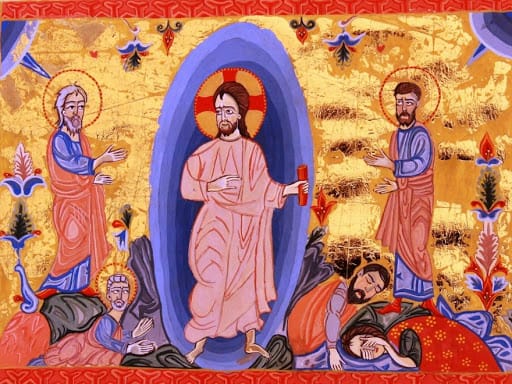FEAST OF THE TRANSFIGURATION

This Sunday, July 7, the Armenian Church observes one of its five major feasts, the Feast of the Transfiguration of our Lord Jesus Christ (Aylagerbutiun/Vartavar). This Feast is observed fourteen weeks after Easter, and therefore can fall between June 28 and August 1. It commemorates an episode in the New Testament recorded by Matthew, Mark, Luke, and Peter, recalling Christ’s ascent up Mount Tabor with disciples John, James, and Peter.
The Transfiguration took place on the “holy mountain” (believed to be Mt. Tabor) where Jesus went with his three disciples. As He was praying, “His face shone like the sun and his garments became white as light.” Moses and Elijah appeared at his side, representing the law and the prophets. It was at this moment that his appearance was “transfigured” revealing himself as God to his disciples as a voice from above said, “This is my beloved Son, with whom I am well pleased. Listen to him.” Jesus urged his disciples to keep silent about what they saw, but the incident was recorded in the Gospels.
The pre-Christian festival Vartavar (Festival of Roses) was assimilated into this new Christian holiday. Armenians would decorate the temple of the goddess Asdghig (goddess of love, beauty, fertility, and water) with roses, release doves, and engage in water games on this popular pre-Christian holiday. St. Gregory the Illuminator combined Vartavar with the Transfiguration. The fifth century historian Yeghishe wrote the prayer that is recited in church on this feast: “O Lord, bless the harvest of this year and defend from all the perils, and may your right hand, O Lord, protect us for the whole year.”
Vartavar became a traditional day of pilgrimage to churches named in honor of St. John the Baptist. The most popular destination was the Monastery of Sourp Garabed of Mush, founded by Gregory the Illuminator in the province of Taron near Mush. (Garabed means Forerunner, referring to John the Baptist). The monastery was large and expansive and built like a fortress in the mountains. More than one thousand pilgrims could be accommodated. After 1915 the complex ceased to exist. The monastery was destroyed by the Turkish army, and the ravages of time, weather and scavengers completed its destruction. The once large and thriving Armenian monastery is now a mass of stone and rubble.
This Sunday is the name day for those named Vartkes, Vartavar, Vart, Vartouni, Vartanoush, Vartiter, Varvar, Vartivar, Alvart, Sirvart, Lousvart, Hyvart, Baidzar.
